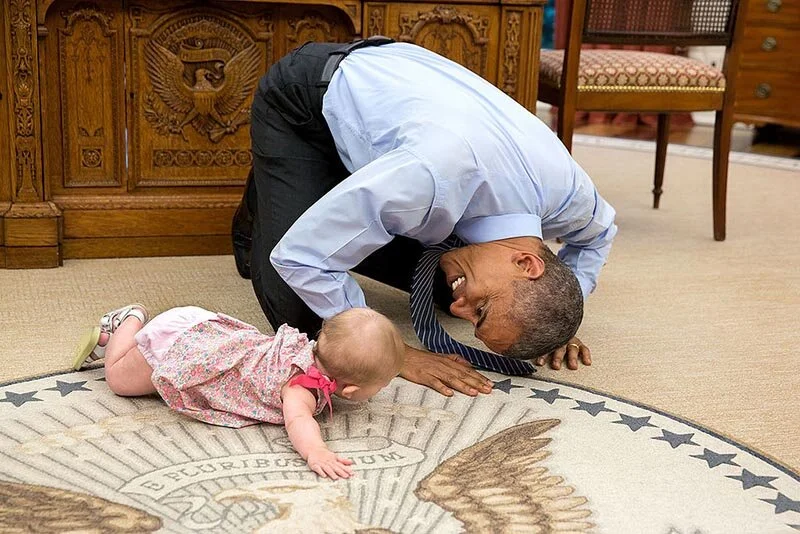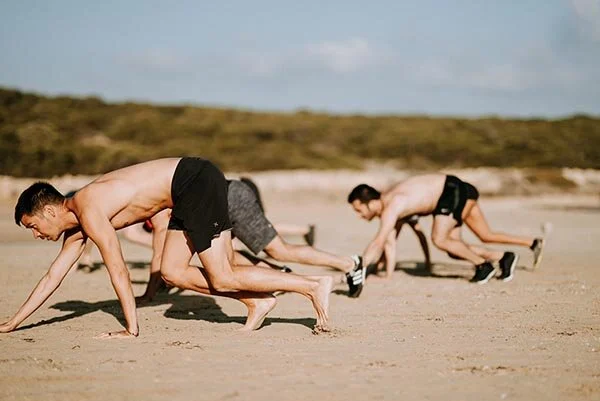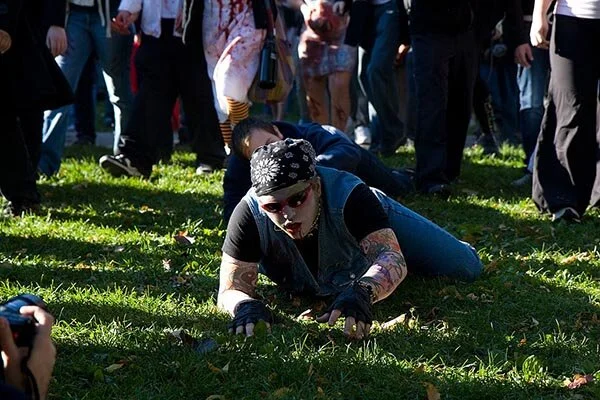Why We Should All Try Crawling As Adults
It looks funny and it’s hell on your knees, but for babies and grown-ups alike, crawling is a full-body workout that can also help erase some of the most common aches and pains.
By Jessie Schiewe
President Barack Obama practiced crawling with Deputy National Security Advisor Ben Rhodes’ newborn, Ella, in 2015. (Wikimedia Commons / The White House)
If Tim Anderson had it his way, crawling for adults wouldn’t be a comedic stunt on TikTok or a cam girl’s technique for titillating viewers.
On the contrary, crawling would become an everyday activity for adults, a daily workout in the same vein as going on a walk or doing push-ups.
Instead of doing it to lose weight or get ripped, however, the goal would be more holistic — and ambitious.
Crawling can strengthen muscles, especially the core, but the thing it’s most lauded for is its re-alignment capabilities.
From improving posture to strengthening neural connections, crawling as an adult takes us back to early childhood when our bodies were first growing and developing.
Crawling’s ability to correct years of damage and return us to our earliest state of mobility is why Anderson calls it a “reset” for our physical health. Along with a handful of other simple, “child-like” movements, he’s been promoting crawling for years through Original Strength, a fitness practice he helped co-found, that now has certified coaches around the country.
“You were made to crawl,” Anderson wrote in Pressing Reset, a free e-book he published in 2013 that is one of the handful of crawling-related works he’s written in the last 10 years.
“Crawling, the simple way you learned to go investigate the world as a baby, is the way you once built a reflexively strong and stable body. At one time in your life, you used crawling to tie your body together — literally.”
Bipedal life has its advantages, but there’s also plenty of room for damage, which is where adult crawling comes into play. It can reverse longstanding (bad) habits and jumpstart old patterns of movement and connectivity that maybe your body had forgotten.
And, with the majority of us hunkered down in quarantine, spending more time being sedentary than normal, now might be the opportune time to give crawling a try.
Long hallways are perfect for practicing crawling…especially if you can’t make it to the beach.
Even if it’s done for only three or 10 minutes a day, the simple movement can have a positive impact on the body, with longtime crawlers crediting it for reversing rounded shoulders, loosening tight fascia, improving hip stiffness, and lessening back pain, among other benefits.
A scalable exercise, crawling can be done at any age and anywhere. It also doesn’t require equipment, although knee pads are highly encouraged especially for beginners or those without carpeting.
“The Teenage Girls Who Jump Like Horses”
Though still far from mainstream, adult crawling is catching on in some fitness circles. In 2016, Anderson trained the coaching staff of the Cleveland Cavaliers on Original Strength methods, and professional athletes, such as former center fielder for the San Francisco Giants Denard Span, reportedly also included crawling into his strength and conditioning practices.
An adult showing off their crawling skills at a “Zombie Walk” in Toronto, Canada. (Wikimedia Commons / veggiefrog)
And in many ways, crawling is already incorporated into certain workout regimes. You might find yourself doing bear crawls in a cardio class, learning front crawls during a swimming lesson, or practicing forward-backward crawls if you ever need physical or rehabilitative therapy.
Washington, D.C., chiropractor Justin Klein is a particularly vocal proponent of the Original Strength method, and once organized a free “Crawl on the Mall” event for the public that involved “baby crawling challenges” and a one-mile crawling race.
Even babies need assistance when they first start crawling, like this one in 1907. (Wikimedia Commons / Deseronto Archives)
In the event’s online flyer, he billed it as a chance to “join an elite group of movers with a unique and truly mindful understanding of how your own body works at its best.”
Just don’t expect things to “click” right away the first time you try it.
Experienced crawlers say the quadruped movement can feel awkward and clumsy in the beginning as we readjust to the odd positioning and new pressure points on our bodies.
The key to working through this, they say, and getting to the point where crawling is fun and not embarrassing, is to be patient with yourself and diligent with your practice.
With time, your adult body will reintegrate into the same movement patterns you followed as an infant. The only difference is that now, instead of wearing diapers, you’re wearing knee pads.







Who knew these cute, little songs were so macabre?